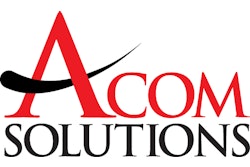Supply Chain Solutions targets multi-client supplier mall at manufacturers importing, exporting goods to and from Asian markets
Grand Rapids, MI April 4, 2005 — Grand Rapids-based Supply Chain Solutions, a specialist in collaborative supply chain techniques, has been asked to operate a West Coast logistics facility to offer an option for global manufacturers that transport goods to and from Asia.
The center is a transload logistics center, which means that freight coming into the United States from Asia — or heading out — can travel through it. Supply Chain Solutions opened its first multi-client logistics center in Grand Rapids, Mich., late in 2004.
The company originally partnered with tier-one auto supplier Delphi on the decision to open the facility in Ontario, Calif., and other Michigan-based companies such as National Nail and a large office furniture manufacturer have agreed to participate. Currently, similar West Coast operations are at 100 percent capacity from the extreme heavy flow of goods between the United States and Asia.
"These centers work because they bring together a number of shared resources that allow participating companies to have decreased inventories, more reliable delivery schedules and improved tracking and visibility throughout the supply chain," said Les Brand, CEO of Supply Chain Solutions.
The solution provider said that the Ontario logistics center was designed so that several clients across a variety of industries can take advantage of efficiencies in the following areas:
"We are allowing companies to use only the parts of the supplier center that they need, from handling inbound raw materials or finished product, to managing product movement across the [United States]," said Jim Ward, chief operating officer of Supply Chain Solutions. "We don't consider this a service; we consider it a customizable transportation solution."
The new logistics center, due to be operational in March, will serve as a Western distribution hub for three companies to start, with the capacity to handle the needs of up to 15 manufacturers or distributors. Any company that ships goods across the U.S. market from docks in Asia and facilities in Mexico, Texas and California is eligible to participate, and Supply Chain Solutions said it is actively seeking additional tenants.
Max Alire, a 24-year industry veteran formerly of Apple and Ryder Logistics, has been hired to manage the Ontario facility.
For more information on the latest trends in the logistics space, see the article "The Analyst Corner: Fulfillment & Logistics" in the October/November 2004 issue of Supply & Demand Chain Executive.
Grand Rapids, MI April 4, 2005 — Grand Rapids-based Supply Chain Solutions, a specialist in collaborative supply chain techniques, has been asked to operate a West Coast logistics facility to offer an option for global manufacturers that transport goods to and from Asia.
The center is a transload logistics center, which means that freight coming into the United States from Asia — or heading out — can travel through it. Supply Chain Solutions opened its first multi-client logistics center in Grand Rapids, Mich., late in 2004.
The company originally partnered with tier-one auto supplier Delphi on the decision to open the facility in Ontario, Calif., and other Michigan-based companies such as National Nail and a large office furniture manufacturer have agreed to participate. Currently, similar West Coast operations are at 100 percent capacity from the extreme heavy flow of goods between the United States and Asia.
"These centers work because they bring together a number of shared resources that allow participating companies to have decreased inventories, more reliable delivery schedules and improved tracking and visibility throughout the supply chain," said Les Brand, CEO of Supply Chain Solutions.
The solution provider said that the Ontario logistics center was designed so that several clients across a variety of industries can take advantage of efficiencies in the following areas:
- Consolidating inbound and outbound freight costs.
- Sharing a workforce so that any downtime for one manufacturer is offset by the busy times of another, securing 110 jobs year-round.
- Manufacturers and distributors can take advantage of the ability to distribute directly from Asia to customers, rather than making a stop in Michigan.
- Combined assistance in meeting Foreign Trade Zone requirements and consolidating nationwide shipments that come in from Asia.
- Shared availability of onsite experts in inspections, packaging, testing, customs, returns handling and other duties that normally consume a significant percentage of the cost of manufacturing goods.
- A shared workforce that is bilingual and fully supported in training and education.
"We are allowing companies to use only the parts of the supplier center that they need, from handling inbound raw materials or finished product, to managing product movement across the [United States]," said Jim Ward, chief operating officer of Supply Chain Solutions. "We don't consider this a service; we consider it a customizable transportation solution."
The new logistics center, due to be operational in March, will serve as a Western distribution hub for three companies to start, with the capacity to handle the needs of up to 15 manufacturers or distributors. Any company that ships goods across the U.S. market from docks in Asia and facilities in Mexico, Texas and California is eligible to participate, and Supply Chain Solutions said it is actively seeking additional tenants.
Max Alire, a 24-year industry veteran formerly of Apple and Ryder Logistics, has been hired to manage the Ontario facility.
For more information on the latest trends in the logistics space, see the article "The Analyst Corner: Fulfillment & Logistics" in the October/November 2004 issue of Supply & Demand Chain Executive.









